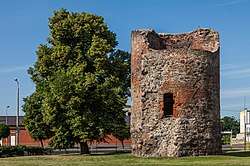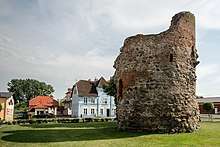Kowalewo Pomorskie
| Kowalewo Pomorskie | ||
|---|---|---|
 Ruins of a medieval tower | ||
| ||
 Kowalewo Pomorskie | ||
| Coordinates: 53°10′N 18°54′E / 53.167°N 18.900°E | ||
| Country |
| |
| Voivodeship | Kuyavian-Pomeranian | |
| County | Golub-Dobrzyń | |
| Gmina | Kowalewo Pomorskie | |
| Established | 13th century | |
| Town rights | 1275 | |
| Government | ||
| • Mayor | Andrzej Grabowski | |
| Area | ||
| • Total | 4.45 km2 (1.72 sq mi) | |
| Population (2006) | ||
| • Total | 4,055 | |
| • Density | 910/km2 (2,400/sq mi) | |
| Time zone | UTC+1 (CET) | |
| • Summer (DST) | UTC+2 (CEST) | |
| Postal code | 87-410 | |
| Area code(s) | +48 56 | |
| Car plates | CGD | |
| Website | kowalewopom.pl | |
Kowalewo Pomorskie [kɔvaˈlɛvɔ pɔˈmɔrskʲɛ] (German: Schönsee) is a town in Golub-Dobrzyń County, Kuyavian-Pomeranian Voivodeship, Poland. It is the capital of the Gmina Kowalewo Pomorskie. From 1975–1998 the city belonged to the Toruń Voivodeship.
According to data from December 31, 2004, Kowalewo Pomorskie had 4,130 inhabitants.
History
.jpg)
The name Kowalewo can be roughly translated as the "place of a smith". The town was arranged into a rectangular shape, with a typical Central European marketplace. During the times of the Teutonic Knights, Kowalewo was privileged to have its own coat of arms, which represented two red fish on a white background. The coat of arms was modified over the centuries, with one red fish being retained.
In the beginning, the town's commander was Rudolf Kowalewo, who owned 1,000 serfs. Kowalewo was then located in Royal Prussia and in 1455 Casimir IV Jagiellon (1440–1492) appointed the city's foreman, Gabriel Bazynski. Later, when viovode Chelminski was in power, Jan Plemieki, a courtier of the king, was made foreman of Kowalewo Castle. All that remains of this castle today is a ruined defensive tower, a local attraction and current symbol of the town.
The Church of St Nicholas and St Ann were both established in Kowalewo in 1670. The voivode (governor) was then Jan Dzialynski. During the Swedish Deluge, on February 11, 1629, Field Marshal Wrangel ordered the Swedes to plundered and sack Kowalewo. From 1655 until 1657, the Swedes occupied the area once more. The subsequent Prussian and Swedish wars, which continued for eighteen years, turned the region into rubble.
.jpg)
There were a series of civil wars during the reign of Augustus II the Strong of Saxony (1697–1704, 1709–1733) and under Stanisław I Leszczyński (1704–1709, 1733–1736). On October 5, 1716, during Leszczynski's rule, the Russian army took what was left of Kowalewo's supplies. The town had 1,000 citizens and 120 homesteads before these wars, and by 1772 it had only 300 citizens and 34 homesteads.
On September 16, 1772, the foreman of Kowalewo's voivode, Franciszek Stanislaw Czapski, signed an oath to the Prussian king, Frederick II the Great (1740–1786). This resulted in the town becoming Germanized, as German colonists came to build new homesteads and farms. All former governments were replaced and were now part of the Marienwerde. The new government permitted Polish shoemakers, blacksmiths, bricklayers, and carpenters to continue operation.
Many Poles were required to join the Prussian military by the order of Frederick II. Many deserted from their compulsory service in the army. The Prussians also sought to increase the taxes. It was later part of the Duchy of Warsaw under Napoleon and local peasants also contributed to the January Uprising.

In 1873, there was a voluntary fire brigade in Kowalewo, and by 1883, the town had its first bank.
